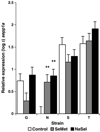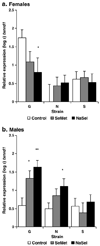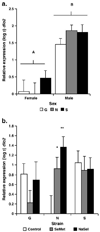Zebrafish (Danio rerio) vary by strain and sex in their behavioral and transcriptional responses to selenium supplementation
- PMID: 20659579
- PMCID: PMC3047475
- DOI: 10.1016/j.cbpa.2010.07.016
Zebrafish (Danio rerio) vary by strain and sex in their behavioral and transcriptional responses to selenium supplementation
Abstract
We used the Nadia, Gaighatta, Scientific Hatcheries, and TM1 zebrafish (Danio rerio) strains to test the hypothesis that variation among populations influences the behavioral and transcriptional responses to selenium supplementation. When fed a diet with control levels of selenium, zebrafish strains differed significantly in behavior, characterized as their mean horizontal and vertical swimming positions within the tank. The four strains also differed in brain expression of selenoprotein P1a (sepp1a), glutathione peroxidase 3 (gpx3), thioredoxin reductase 1 (txnrd1), and tRNA selenocysteine associated protein 1 (secp43). Iodothyronine deiodinase 2 (dio2) did not differ among strains but showed a sex-specific expression pattern. When supplemented with selenium, all strains spent a greater proportion of time near the front of the tank, but the response of vertical swimming depth varied by strain. Selenium supplementation also caused changes in selenoprotein expression in the brain that varied by strain for sepp1a, secp43, and dio2, and varied by strain and sex for txnrd1. Expression of gpx3 was unaffected by selenium. Our data indicate that selenium homeostasis in the brain may be a regulator of behavior in zebrafish, and the strain-specific effects of selenium supplementation suggest that genetic heterogeneity among populations can influence the results of selenium supplementation studies.
Copyright © 2010 Elsevier Inc. All rights reserved.
Figures







Similar articles
-
Selenium prevents downregulation of antioxidant selenoprotein genes by methylmercury.Free Radic Biol Med. 2014 Oct;75:95-104. doi: 10.1016/j.freeradbiomed.2014.07.019. Epub 2014 Jul 23. Free Radic Biol Med. 2014. PMID: 25064324
-
Analyses of Selenotranscriptomes and Selenium Concentrations in Response to Dietary Selenium Deficiency and Age Reveal Common and Distinct Patterns by Tissue and Sex in Telomere-Dysfunctional Mice.J Nutr. 2017 Oct;147(10):1858-1866. doi: 10.3945/jn.117.247775. Epub 2017 Aug 30. J Nutr. 2017. PMID: 28855418
-
Responsiveness of selenoproteins to dietary selenium.Annu Rev Nutr. 1999;19:1-16. doi: 10.1146/annurev.nutr.19.1.1. Annu Rev Nutr. 1999. PMID: 10448514 Review.
-
Roles of selenoprotein antioxidant protection in zebrafish, Danio rerio, subjected to dietary oxidative stress.Fish Physiol Biochem. 2015 Jun;41(3):705-20. doi: 10.1007/s10695-015-0040-2. Epub 2015 Mar 7. Fish Physiol Biochem. 2015. PMID: 25750091
-
Effects of dietary selenium on the tissue concentrations of type I iodothyronine 5'-deiodinase and other selenoproteins.Am J Clin Nutr. 1993 Feb;57(2 Suppl):310S-312S. doi: 10.1093/ajcn/57.2.310S. Am J Clin Nutr. 1993. PMID: 8427210 Review.
Cited by
-
Inbred strains of zebrafish exhibit variation in growth performance and myostatin expression following fasting.Comp Biochem Physiol A Mol Integr Physiol. 2013 Jan;164(1):1-9. doi: 10.1016/j.cbpa.2012.10.004. Epub 2012 Oct 6. Comp Biochem Physiol A Mol Integr Physiol. 2013. PMID: 23047051 Free PMC article.
-
Brain transcriptome variation among behaviorally distinct strains of zebrafish (Danio rerio).BMC Genomics. 2012 Jul 20;13:323. doi: 10.1186/1471-2164-13-323. BMC Genomics. 2012. PMID: 22817472 Free PMC article.
-
Transcriptome profiling reveals that feeding wild zooplankton to larval Atlantic cod (Gadus morhua) influences suites of genes involved in oxidation-reduction, mitosis, and selenium homeostasis.BMC Genomics. 2015 Nov 26;16:1016. doi: 10.1186/s12864-015-2120-1. BMC Genomics. 2015. PMID: 26610852 Free PMC article.
-
SEXUAL DIMORPHISM IN SELENIUM METABOLISM AND SELENOPROTEINS.Free Radic Biol Med. 2018 Nov 1;127:198-205. doi: 10.1016/j.freeradbiomed.2018.03.036. Epub 2018 Mar 21. Free Radic Biol Med. 2018. PMID: 29572096 Free PMC article. Review.
-
Population genomics of wild and laboratory zebrafish (Danio rerio).Mol Ecol. 2011 Oct;20(20):4259-76. doi: 10.1111/j.1365-294X.2011.05272.x. Epub 2011 Sep 16. Mol Ecol. 2011. PMID: 21923777 Free PMC article.
References
-
- Altmann J. Observational study of behavior: sampling methods. Behaviour. 1974;49:227–267. - PubMed
-
- Álvarez D, Nicieza AG. Predator avoidance behaviour in wild and hatchery-reared brown trout: the role of experience and domestication. J. Fish Biol. 2003;63:1565–1577.
-
- Apostolou S, Klein JO, Mitsuuchi Y, Shetler JN, Poulikakos PI, Jhanwar SC, Kruger WD, Testa JR. Growth inhibition and induction of apoptosis in mesothelioma cells by selenium and dependence on selenoprotein SEP15 genotype. Oncogene. 2004;23:5032–5040. - PubMed
-
- Benton D. Selenium intake, mood and other aspects of psychological functioning. Nutr. Neurosci. 2002;5:363–374. - PubMed
Publication types
MeSH terms
Substances
Grants and funding
LinkOut - more resources
Full Text Sources
Medical
Molecular Biology Databases
Research Materials
Miscellaneous

